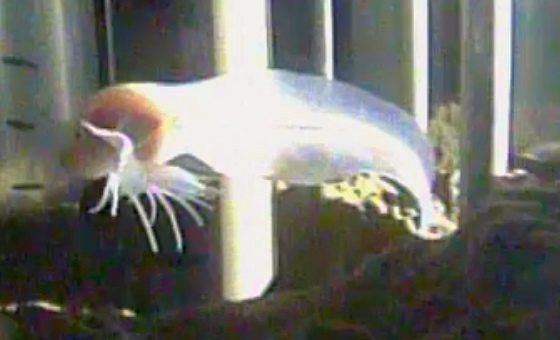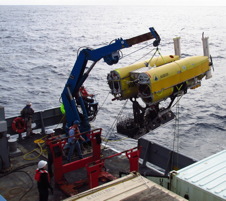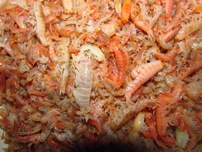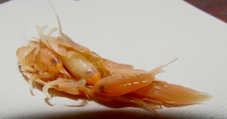

Deepest-Living Fish discovered on our Mariana Trench SOI expedition, Nov.-Dec. 2014
Note: in 2023 a deeper, closely related fish was filmed in a neighboring trench (see below).
 |
 Deepest-Living Fish discovered on our Mariana Trench SOI expedition, Nov.-Dec. 2014 Note: in 2023 a deeper, closely related fish was filmed in a neighboring trench (see below). |
|
Old and new
hadal submersibles
The manned bathyscaphe Trieste which reached the Mariana Trench bottom in 1960 (now in the Naval Museum in D.C.)  Unmanned HROV Nereus, which reached that same site in 2009 and used in our 2014 HADES expedition, Kermadec Trench. Sadly, Nereus is gone.  Hadal lander from U.
Aberdeen -- HADEEP, HADES programs.
(click picture for details) |
|
The Deepest Ocean Habitat--The Hadal Zone--is found in the deep troughs and trenches which go from 6000m to 11,000m max in the Mariana Trench. 'Hadal' is derived from Hades (the Greek word for the Underworld for dead souls and its god]. These habitats have the highest ocean pressures, are eternally just above freezing and without sunlight (which disappears completely by a mere 1,000 m / 3,300 ft), and may be very variable in food supply. They are the least explored habitat on earth (other than the subsurface biosphere), and we know more about the topography of the Moon and Mars than we do about the trenches! Worldwide there are about 15
tectonic subduction trenches with hadal depths
(see MAP on our HADES
website), and several deep non-subduction
troughs. These had been little explored since the 1950s, when the
Soviet Vityaz (or Vitjaz) and
the Danish
Galathea 2 ships were used
with nets and dredges to bring up animals from numerous trenches.
However, nets have many problems, including: they are blind 'shots
in the dark (you cannot target what you want)'; they let smaller
and fast organisms escape; they destroy community structure; and
they often destroy gelatinous animals. A bathyscaphe, the
Trieste (see picture, right)
manned by Jacques Piccard and Don Walsh, reached the very deepest
ocean (Challenger Deep of the Mariana Trench, almost 36,000 ft /
11,000 m) in 1960, but no significant science was done as their
window began cracking, so they ascended soon after reaching the
bottom. Trenches have been receiving renewed attention with advances in high-pressure technology: The Japanese ROV Kaiko was used in the Japan and Mariana Trenches in the 1990s; new baited camera/trap landers have been deployed since 2008 by University of Aberdeen (see pictures, right) and Scripps Inst. Oceanogr.; the Nereus hROV (see picture, right; unmanned sub, now lost) from Woods Hole Oceanogr. Inst. was used in the Mariana (2009) and our HADES program, 2014, in Kermadec Trench; and James Cameron's DEEPSEA CHALLENGER manned sub reached the Mariana Trench bottom in 2012. All these recent programs have yielded news-making results (see NEWS page and search for "trench"). IN
2014, OUR GROUP COMPLETED THE FIRST DETAILED
EXPLORATION OF THE MARIANA TRENCH using
SOI, U.
Aberdeen (spectacular videos HERE)
and U. Hawai'i landers; including the WORLD'S
DEEPEST FISH (until 2023 when a deeper,
closely related fish was filmed in a neighboring trench). |
|
|
Other HADES program equipment BELOW:
SOI hadal elevator
landers, on which instruments can
be placed (e.g., by an ROV, to run an experiment 1 or more
days). |
AMPHIPODS:
The
dominant mobile animals at the greatest hadal depths!
 Above: Enormous numbers caught at 8000 m 
Above: H. dubia amphipods eating a larger amphipod (from 8000m). Most amphipods are scavengers, eating dead organisms that sink to the deep-sea floor. At this depth and below, there appear to be no predatory fish to keep amphipod populations in check. Perhaps as a result, amphipods also eat other amphipods, even becoming cannibals (where one eats its own species)! There are also predatory Princalexia amphipods and SUPERGIANTS! See below |
WHAT LIVES IN THIS
EXTREME HABITAT?
Microbes and animals! At the greatest depths, pressure-tolerant bacteria & archaea thrive (more on this HERE). Sea cucumbers such as sea pigs, various worm phyla, anemones, and amphipods (see photos, left; familiar to many people as tiny beach fleas) and the related isopods (familiar as terrestrial pill bugs or rolly pollies) dominate the larger fauna on or above the seafloor. Giant single-celled foraminifera called xenophyophores are common in some areas. Foraminifera in shallow waters have CaCO3 (limestone) shells, but these dissolve at high pressure; so xenophyphores make odd shells out of materials from the local environment. There are also tiny animals in the sediment called meiofauna. Curiously, many common marine groups including decapods (e.g., shrimp, crabs) and fish are absent from the greatest depths, about 8,500-11,000 m. Also most mollusc groups are absent, in part because CaCO3 shells dissolve under high pressure (some snails are found in the hadal zone, but their shells are like paper). But even unshelled molluscs--squids, octopods--are missing at the greatest depths. MORE ON FISH: sharks and their relatives (cartilagious fish) have not been found below about 4000 m; but bony fish go deeper. The 1960 Trieste aquanauts, at 11,000 m in the Mariana Trench, reported seeing a flatfish swim by; however, as no other flatfish have been found below 2,000 m anywhere in the world, and as no fish of any kind have been found below 8400 m anywhere else, most biologist believe that they saw a swimming flat sea cucumber such as Benthodytes, or the “flattened-cushion shaped” Galatheathuria aspera, which is white, oval, and about a foot long. We have written a detailed article debunking the Trieste "flatfish." We have also published evidence suggesting that fish may not be able go below about 8000-8500 m due to biochemical limitations. Read more on this and fish pressure adaptations HERE, and our 2014 discovery of the world's deepest fish yet. SEE
ALSO: Hadal trenches: the ecology of the
deepest places on Earth. A
J Jamieson, T Fujii, D J Mayor, M Solan, I G Priede. |
|
BELOW: Some of the animals that we caught in 2014 in A. Kermadec Trench, and B. Mariana Trench:
| A. Kermadec Trench 2014 HADES expedition (on the Thompson with Nereus): bathyal zone @1500m, abyssal zone @4000-5000m and hadal zone @6000-10,000m | |||||
|
BATHYAL (1500 m)
& ABYSSAL AMPHIPODS
we caught 4000-5000m
|
|||||
|
Amphipod from 1500m
Note orange 'eyepatch' |
Amphipod from 4000m
Compare the odd orange 'eyepatch' to that of the 1500m species |
Amphipods from 5000m
Again, notice the orange 'eyepatches' and a blind species |
SUPERGIANT
amphipod (Alicella gigantea),
from 7000m. Read more about its capture in 2011 here; see a bigger one from the Mariana Trench below |
Left: Hirondellea
dubia found 7000-10,000m; predatory
Princalexia amphipod from 8100m (named
by Galathea scientists after Prince Alex of Denmark) Right: Scopelocheirus schellenbergi 9000m; blind species that rolls into a ball when disturbed |
|
|
Kermadec Trench
continued
|
|||||
|
BATHYAL (1500 m)
and ABYSSAL FISH
caught (4000-5000m)
|
HADAL
FISH caught
(6200 - 7500m)
|
||||
 |
|||||
|
A synaphobranchid eel Diastobranchus
from 1500m
See a video of viscious feeding: Click here then select "Eat or be Eaten"! |
A ratttail or grenadier, Coryphaenoides
yaquinae,
From 4000 m. Rattails are perhaps the most common abyssal fishes. |
A zoarcid eel, Pachycara
sp.,
from 4000, 5000 m. |
Cuskeel Spectrunculus sp.
From 4000, 5000 m. Cuskeels are one of the deepest-living fish groups. Our expedition (thanks to Alan Jamieson) discovered a wild vacuum-hose mode of feeding. Click here for video: select "Grabbing a Quick Bite" |
The gelatinous transparent Kermadec
snailfish Notoliparis kermadecensis from
6500, 7500 m, deepest known fish in the Southern Hemisphere! See
picture of live one (and link) at the far upper
right of this page. Our
analysis suggests it cannot live below about 8000m.
|
|
|
Kermadec Trench
continued
|
|||||
|
HADAL ANEMONE
|
HADAL DECAPOD
|
HADAL CRINOID
|
HADAL HOLOTHURIANS (SEA
PIGS / SEA CUCUMBERS)
|
||
|
Tube anemone from 7000 m
|
Shrimp Benthesicymus crenatus 6500m.
Read about the
2008 hadal discovery of these here.
|
Sea lily (crinoid) from 7000m
|
Sea pigs from 7000m, including
a swimming species we filmed, shown in <strong><em>Blue Planet II Episode 2 </em></strong>(erroneously called a sea slug). |
Sea pigs / sea cucumbers from 8000m
|
|
|
||||||||||||||||||||||||||||||||||||||||||||||||||||||||||||||||||||||||||||||||||||||||||||||||||||||||
| Return to Main Page with Contents |